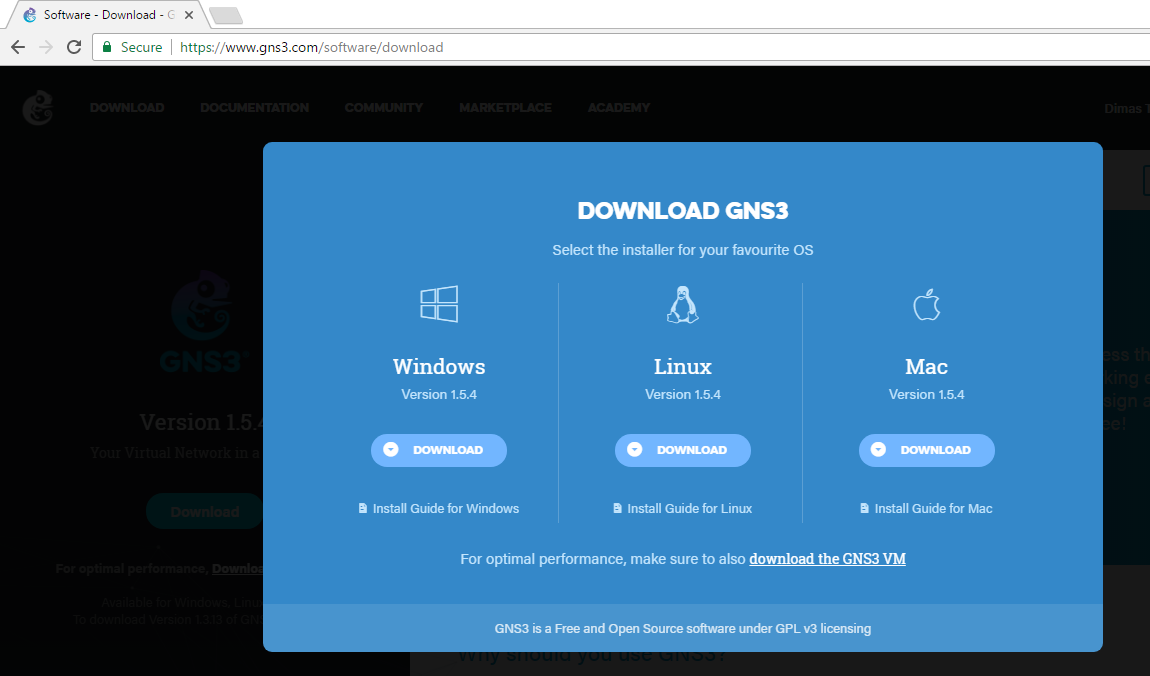

- #GNS3 WINDOWS 10 INSTALL#
- #GNS3 WINDOWS 10 ZIP FILE#
- #GNS3 WINDOWS 10 WINDOWS 10#
- #GNS3 WINDOWS 10 PC#
#GNS3 WINDOWS 10 WINDOWS 10#
Note: In Windows 11 and Windows 10 latest, you should allow.
#GNS3 WINDOWS 10 INSTALL#
Use Windows 10 instead (I guarantee you all the functionality available in 7 will be available in 10).Ģ) Download the official Windows 10 ISO from here: ģ) The ISO is about 5.5GB at the time I'm writing this post.Ĥ) Create a new VM in whatever software you are using, and install using the ISO.ĥ) You don't need to activate it. Pre-installed GNS3 images, GNS3 Full Pack, Cisco images, SD-WAN, ALL other vendors already. It is out of date, out of support and potentially creates a vulnerability if you connect it to the Internet. You did not mention what VM software you are using (VirtualBox, VMWare Workstation, KVM, QEMU, ProxMox, ESXi, HyperV, etc.) so these are generic instructions:ġ) You should not be using Windows 7. You also don't need a qcow, or to do anything fancy. While ($StopWatch.I think the file you're provided is too large - 12GB is fine once it's installed, but not for the plain ISO. GNS3-Errors-No-connection-could-be-made-because-the-target-machine-actively-refused-it. $TimeOut300 = New-TimeSpan -Seconds $StartGNS3TimeLimit This action will extract out the drives and the PowerShell script to create the VM.

Extract all on the GNS3.VM.Hyper-V.2.2.17.zip.
#GNS3 WINDOWS 10 ZIP FILE#
# Put the TcpClient in a while loop with a maxtime of 300s Once the setup has completed, a zip file 'GNS3.VM.Hyper-V.2.2.17.zip' is downloaded to the same folder as the installation file, containing the drives and the PowerShell script to create the Hyper-V vm. $msg = "Attempting TCP Connect from $Vmnet1Address to " + $Vmnet1 = Get-NetIPAddress = $Vmnet1.IPAddress $Vmnet1Params = 'VMware Network Adapter VMnet1' $Gns3VMIP = & $GetVmrunResultSB -cmd $vmrunip

I do not make a move on anything without seeing if david bombal said to do something a certain way.Īnd.Tisou looks to have made his "deb-vm" the 'gns3 vm' because he named the "gns3 vm" "gns3" - that crushed me. Gns3 users do not install gns3 and run over to see what david bombal says to do. gns3 file, I will know if everything is configured properly in vmware or not. GNS3 installation carries on and downloads required packages. GNS3 is a graphical network simulator that allows you to design complex network topologies.

Click Next > to continue the installation: GNS3 comes bundled with various prerequisite and optional software. So if you are running Windows 7 appliance or Windows 10. Umm, again back to you Ean, we wait until 3.0, but then this is an architecture decision by the gns3 developers.ĭo they want to have a laissez-faire approach to this or not. Select the Start Menu folder for the GNS3 shortcut. I tried Windows 10 download, GNS3 wouldnt take it either, saying the MD5 for the files dont match.
#GNS3 WINDOWS 10 PC#
I only need powershell and the ip address of the gns3 vm so i can logon to it. This video help you to setup a virtual labsetup for your ccna / ccnp /ccie learning purpose.you must have pc that supports virtualization, windows operating. Wireshark: Recommended : It is used to capture and view data packets exchanged between nodes. If you are installing GNS3 on a previous version of Windows, select WinPCAP. If you are installing GNS3 on Windows 10 or higher, select Npcap. I need no vms in my topology - i only need wireshark - I do not even need wireshark. Based on the version of Windows, select either Npcap or WinPCAP. Wait while the Cisco simulator program is installed on your Windows 10 computer. In the Choose Install Location window, select where you want to set up the program and click Next. Vmnet1 host-only first or i could a vmnet8 nat interface 1st or i could add a bridged interface 1st. In the Choose Components window, check one of its new features, WebClient, and click on Next. It allows users to simulate network performance and is a rival Cisco’s packet tracer. I can delete all vmnets in vmware and add a GNS3 is an open source software for network planning and development. Someone would have to look in the gns3 code. To the best of my knowledge eth0, eth1, or eth2 mean nothing on the gns3 cloud. The way that david does it is the right way. I just spent 10 hours with tisou on this: The way gns3 is troubleshot and implemented vis a vis the gns3 cloud is all based on David Bombal.


 0 kommentar(er)
0 kommentar(er)
